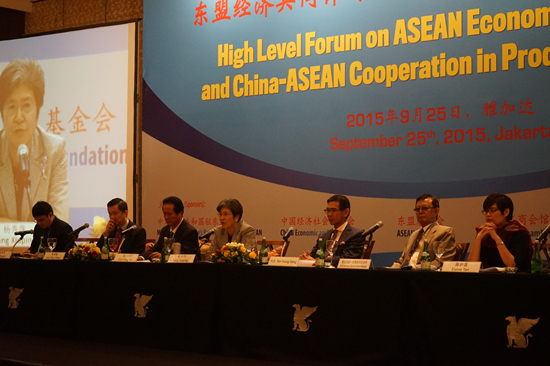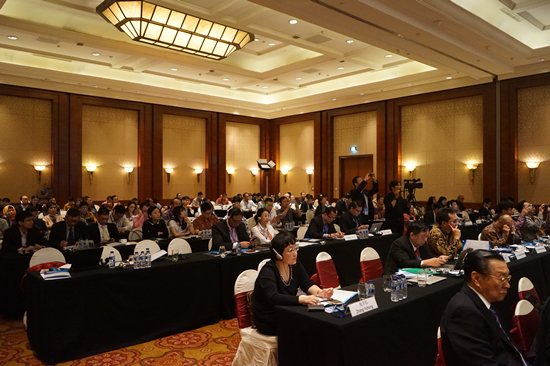On 25 September 2015, the High-level Forum on ASEAN Economic Community (AEC) and ASEAN-China Cooperation in Production Capacity, co-hosted by the Chinese Mission to ASEAN, China Economic and Social Council, ASEAN Foundation, China Committee of Indonesian Chamber of Commerce and Industry, and China Chamber of Commerce in Indonesia, was held in Jakarta, Indonesia.

ASEAN-China Centre (ACC) Secretary-General H.E. Mme. Yang Xiuping attended the Forum and delivered remarks. H.E. Mr. Xu Bu, Chinese Ambassador to ASEAN, H.E. Mr. Jia Zhibang, Vice Chairman of China Economic and Social Council, H.E. Dr. Lim Hong Hin, Deputy Secretary-General of ASEAN, Ms. Elaine Tan, Executive Director of ASEAN Foundation, Dato’ Sri Prof. Dr. Tahir, Chairman of China Committee of Indonesian Chamber of Commerce and Industry, Permanent Representatives of ASEAN Member States to ASEAN, Mr. Liu Hao Sheng, President of China Chamber of Commerce in Indonesia, representatives from Indonesian Ministries of Industry and Trade, as well as over 120 participants attended the Forum.
Ambassador Xu Bu said that ASEAN Community would be realized by the end of 2015. AEC would bring opportunities to ASEAN-China cooperation in production capacity. The majority of the countries in the world were at the early stage of industrialization. Cooperation in production capacity would help match the demand and supply sides, promote global economic recovery and facilitate deep integration of global industrial chains. China had developed competitive production capacity in the areas such as high-speed train and nuclear energy, which were cost-effective. China-Singapore Suzhou Industrial Park and China-Thailand Rayong Industrial Park were among the flagship projects. In the future cooperation, China would uphold the principles of market rule, expanding financial channel, docking development strategies, green ideology, openness and inclusiveness.

Vice Chairman Jia Zhibang said that ASEAN-China cooperation entered the Diamond Decade. China proposed to build the ASEAN-China Community of Common Destiny, jointly build the 21st Century Maritime Silk Road, and implement the “2+7” Cooperation Framework. As the second largest economy in the world, China had developed the equipment manufacturing industry which was wide-ranging in categories. ASEAN Community would lay a solid foundation for a prosperous common market. ASEAN-China cooperation embraced a bright future.
DSG Lim Hong Hin remarked that AEC would be a milestone in ASEAN regional integration. In the next 3 months, ASEAN would take effective measures in reducing tariffs, simplifying procedures, harmonizing standards, improving investment climate, promoting SMEs and infrastructure cooperation, and work toward the goal of single market and production base. ASEAN-China cooperation served as an important driving force for addressing the downward pressure of the global economy and financial volatility. ASEAN enjoyed high labor market and abundant natural resources. ASEAN and China shall enhance cooperation in production capacity such as infrastructure, so as to achieve win-win benefits.
Secretary-General Yang expressed that ASEAN Community would be the first sub-regional community in Asia and was a milestone in Asian integration. To further push forward economic integration, ASEAN Member States should strengthen policy coordination, eliminate trade barriers, create cross-border financial industrial chain and strengthen infrastructure connectivity.
Secretary-General Yang expressed that recent years witnessed abundant progress in ASEAN-China win-win cooperation. China-ASEAN Free Trade Area (CAFTA) was established. China remained ASEAN’s largest trading partner, and ASEAN was China’s fourth largest export market, third largest trading partner and second largest source of imports. Nextyear would mark the 25th anniversary of ASEAN-China dialogue relations. Seizing the opportunities of AEC and CAFTA upgrading, both sides should jointly build the 21st Century Maritime Silk Road, boost cooperation in production capacity, strengthen connectivity and promote Lancang-Mekong cooperation, so as to contribute to development and prosperity of our region and boost vitality of East Asia economy.
Secretary-General Yang introduced China’s economic situation. She remarked that China was the second largest economy, country with the largest volume of commodity trade and foreign reserves, as well as third largest investor in the world. China was also the largest trade partner of nearly 130 countries. The Chinese economy entered a "new normal" phase, shifting from high-speed and investment-led growth to medium-to-high and innovation-driven growth. China’ s economy had grown 7 percent for the first six months in 2015. The Chinese economy had resilience, potential and leeway, accompanied by sufficient foreign exchange reserves. The long-term fundamentals for an upward trend remained unchanged.
Secretary-General Yang highlighted that stepping up international cooperation in production capacity was not only conducive to China's economic transformation and upgrading, to revitalize world economy, but also a path ASEAN and China should take to achieve win-win outcomes. Most ASEAN countries were in the early stage of industrialization, and facing urgent need of development, which required enhanced infrastructure and abundant equipments. China, enjoying a large-scale economy, was the largest producer of over 200 industrial products, which were cost-effective. She put forward several suggestions to further cooperation in production capacity that upholding the principles of balancing between justice and benefit, win-win outcome, openness, inclusiveness and market rules, ASEAN and China should enhance government communication, dock economic and industrial strategies with each other, promote major infrastructure projects, improve investment environment and boost financial support.
Mr. Achmad Sigit Dwiwahjono, Director-General of Resilience and Development of International Industry Access of Ministry of Industry, Mr. Bachrul Chairi, Director-General of International Trade Cooperation, Ministry of Trade, and other participants conducted substantial and in-depth exchange of views on “AEC: Prospect and Impact” and “China-ASEAN Cooperation in Production Capacity: Opportunities, Challenges and Suggestions”.
Consensus was reached that the realization of AEC would boost ASEAN development, optimize regional growth and elevate ASEAN’s competitiveness in the world. ASEAN and China had mutual needs and complementary advantages in advancing cooperation in production capacity. Efforts shall be made in areas including trade and investment facilitation, infrastructure, finance, etc.. .
During the Forum, Secretary-General Yang met with the Permanent Representatives of ASEAN countries, renowned entrepreneurs and scholars, and held substantial exchange of views on furthering ASEAN-China cooperation in the new situation.